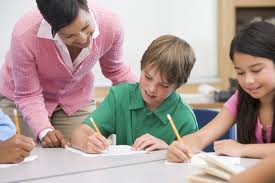
by PRIDE Reading Program Admin | May 19, 2015 | A PRIDE Post, Visual Processing Disorder
Visual processing disorder has nothing to do with eyesight or vision; it has to do with the brain not processing the information which the eyes take in. Children with visual processing disorder have difficulties learning visual information due to the deficits in the visual control system in their brains.
Children diagnosed with visual processing disorder struggle in these 3 areas in reading and writing:
Visual Word Memory Problems
Children with visual processing disorder will often show abnormal behaviors during reading, such as:
- Frequent word or line skips
- Tendency to move their whole head to read instead of just their eyes
- Difficulties with automatic sight-word recognition
- Double vision, squinting or closing or rubbing one eye
- Complaints of visual blurring or letters moving around, popping in and out of the paper
- The letters in words are not in sequence
Letter and Symbol Reversal Problems
It is common for children under the age of 7 to reverse letters or numbers when writing or to make letter substitutions when reading. Children with visual processing disorder will still make reversals and substitutions beyond the age of 7. These children will also show problems with letter formation that extends far beyond simple difficulties with reversals.
Contrast Sensitivity Problems
Children with visual processing disorder often have difficulties with poor visual contrast sensitivity. These children may experience:
- Glare from the paper
- Eyestrain
- Difficulties making out the letters
Symptoms may be worse in some lights than others. Fluorescent lights frequently produce the most problems.
Helping a Child with Visual Processing Disorder
The best learning environment for a child with visual processing disorder is a multisensory setting. Multisensory teaching utilizes all the senses to relay information to the students. The teacher accesses the visual, auditory, and kinesthetic pathways in order to enhance memory and learning.
For example, when learning the vowel combination “oa” the student might first look at it and then have to trace the letters in the air while speaking out loud. This combination of listening, looking, and moving around creates a lasting impression for the student as things will connect to each other and become memorable.
If a child struggling with visual processing disorder is given a task that uses just vision, without drawing upon other senses, the child will be at a disadvantage. When taught with a multisensory approach, children will learn alphabetic patterns and words by utilizing all pathways – hearing (auditory), seeing (visual), touching (tactile) and moving (kinesthetic).
Learn more about the New PRIDE Reading Program
________________________________________________________________________
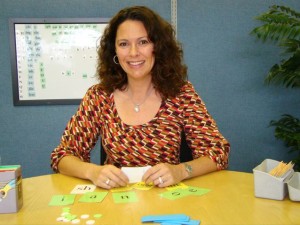
Karina Richland, M.A. is the Founder of Pride Learning Centers, located in Los Angeles and Orange County. Ms. Richland is a certified reading and learning disability specialist. Ms. Richland speaks frequently to parents, teachers, and professionals on learning differences, and writes for several journals and publications. You can visit the Pride Learning Center website at: www.pridelearningcenter.com

by PRIDE Reading Program Admin | May 7, 2015 | A PRIDE Post, Reading Skills
Getting your child interested in reading is one of the most important things you can do as a parent. I understand it isn’t always easy. Just try to think of your time and energy as an investment in your child’s reading future. Here are some practical tips for getting your child interested in reading…
While there aren’t movie equivalents for every book, there is a large selection of children’s literature out there. If you can find them, watch and discuss them together. Some suggestions are: A Series of Unfortunate Events: Lemony Snicket, Charlie and the Chocolate Factory, To Kill a Mockingbird, Charlotte’s Web, Hoot, etc.
- Find books with cartoons or humor — which only a child would find amusing
Not everything needs to be a learning lesson. Letting children read books such as Big Nate or Diary of a Wimpy Kid will keep them engaged and entertained. Although adults might find the language and humor distasteful, children find it very funny and are therefore more motivated to read.
- Zero in on your child’s passions and choose books and magazines focused on areas of interest
Find books on specific topics to keep your child’s interest, such as science, baseball, American Girl dolls, etc. Children who already have the background knowledge, language and vocabulary before beginning a book will have an easier time getting through the reading. Order a magazine subscription to Sports Illustrated for Kids or Nickelodeon. Children love receiving mail and reading ‘their’ magazines.
- Get your child an email account and, together, check it regularly
Using the computer to read and write is a huge advantage for most students. By letting young children write and send email, they practice reading, writing and spelling. Teach your child how to use spell check before sending off messages. Be sure to monitor your child’s ‘pen pals’ – who is your child writing to and receiving mail from? Let your child pick out a few family members, including grandparents and maybe two or three friends. You will find that by using email regularly, your child becomes very strong in typing (keyboarding) and using the computer.
- Find an author that your child likes and stick with it
If your child loves reading Hank Zipzer by Henry Winkler or Tales of a Fourth Grade Nothing by Judy Blume, then you have found a writing style which stimulates your child’s interest. Go through the entire series. Don’t worry if the reading is below grade level: your child is reading for pleasure and for practice. Also remember, just because you loved a certain author or series when you were a kid, this doesn’t mean your child will love the same books you did. Browse the bookstore or library and find the newest, most modern series. Usually these books contain language and themes to motivate the most reluctant reader. Kids need to relate to what they are reading, and modern language usage helps.
- Get books with large print
For some children with learning difficulties, getting books with larger type can be helpful. Maybe it’s because the pages are less intimidating with less text, or maybe it is the fact that there are fewer words on each line, but it seems to make the reading a bit easier.
- Let your child talk to you about the book they are reading.
When we adults read books we enjoy, we like to talk about them. After reading a book, we don’t necessarily want to write a summary, book report or make a project of it. We just want to discuss it with someone else. Look interested in what your child is reading (yes, even if it is Captain Underpants) and ask questions and have your child tell you about it. Laugh with your child about the funny parts (even at the bathroom jokes) and help your child feel good about reading.
Learn more about the New PRIDE Reading Program
_____________________________________________________________________________________________________________________

Karina Richland, M.A. is the Founder of PRIDE Learning Centers, located in Los Angeles and Orange County. Ms. Richland is a certified reading and learning disability specialist. Ms. Richland speaks frequently to parents, teachers, and professionals on learning differences, and writes for several journals and publications. You can visit the PRIDE Learning Center website at: www.pridelearningcenter.com

by PRIDE Reading Program Admin | Apr 24, 2015 | A PRIDE Post, Auditory Processing Disorder
At PRIDE Learning Center, we offer Auditory Processing reading help. It is just amazing how well our kids learn to read, write and comprehend using an Orton-Gillingham reading program.
What is Auditory Processing Disorder?
Auditory Processing is a language processing disorder where a child has significant trouble processing sounds, particularly with the sounds associated with speech. It is a very common learning disability and affects about 5% of school-age children. PRIDE Learning Center offers Auditory Processing Reading Help by using an Orton-Gillingham reading program. This is the program that we at PRIDE are experts at!
What is Orton-Gillingham?
Dr. Samuel T. Orton and Dr. Anna Gillingham developed the Orton-Gillingham approach in the 1930’s. In Orton-Gillingham reading is taught sequentially proceeding from single letters and symbols to one-syllable words and then to longer words. Multisensory approaches are emphasized throughout, with each step of instruction incorporating auditory, visual, and kinesthetic channels. Writing and letter formation are taught systematically, one letter at a time, and each lesson includes emphasis both on auditory and visual aspects of letters and words. Orton-Gillingham includes teaching visual strategies for recognition of phonetically irregular words, and also provides explicit, systematic instruction in the development of vocabulary and reading comprehension.
How does using an Orton-Gillingham reading/spelling program help a child with Auditory Processing Disorder?
Simultaneous Multisensory Instruction: Children with auditory processing deficits who use all of their senses when they learn (visual, auditory, tactile, and kinesthetic) are better able to store and retrieve the information. The child with APD might see the letter B, say its name and sound, and write it in the air all at the same time.
Intensive Instruction: Reading instruction for children with auditory processing must be much more intense, and offer much more practice, than for regular readers.
Direct, Explicit Instruction: Children with APD need to be taught directly and explicitly each and every phoneme (sound) of the English language. They must be taught one spelling rule at a time, and practice it until it is stable in both reading and spelling, before introducing a new rule.
Systematic and Cumulative: Orton-Gillingham starts at the very beginning and creates a solid foundation with no holes. It is taught by presenting one rule at a time and practicing it until the child can automatically and fluently apply that rule both when reading and spelling. Previously learned material is constantly repeated into each new lesson and students progress forward in their reading and spelling with no gaps.
Children with Auditory Processing Disorder need more structure, repetition and differentiation in their reading instruction. They need to learn basic language sounds and the letters that make them, starting from the very beginning and moving forward in a gradual step by step process. This needs to be delivered in a systematic, sequential and cumulative approach. For all of this to “stick” the children will need to do this by using their eyes, ears, voices, and hands.
Learn more about the New PRIDE Reading Program

Karina Richland, M.A. is the Founder of PRIDE Learning Centers, located in Los Angeles and Orange County. Ms. Richland is a Certified reading and learning disability specialist. Ms. Richland speaks frequently to parents, teachers, and professionals on learning differences, and writes for several journals and publications. You can visit the PRIDE Learning Center website at: www.pridelearningcenter.com

by PRIDE Reading Program Admin | Apr 21, 2015 | A PRIDE Post, Writing Disorder
Dysgraphia is a type of learning disability in which an individual has difficulties putting thoughts to words when writing and the overall writing ability falls substantially below what is normally expected. Children with this sort of difficulty will find any sort of written activity to be a painstaking process and may have great difficulty constructing sentences and paragraphs in a grammatical or logical format and struggle tremendously with note- taking.
Dysgraphia Help – Some common symptoms of dysgraphia are:
- Cramped fingers when grasping pencil or pen
- Unusual pencil grip
- Frequent cross-outs or erasures in written work
- Inconsistent writing, mixture of upper and lower case letters, printed and cursive, variations in letter sizes and irregular formation of letters and slants
- Difficulties writing on the lines or within margins
- Very slow writing
- Easily fatigued while writing
- Illegible handwriting
- Many reversals of letters and numbers
- Some words are written backwards
- Letters might be out of order
- Difficulties organizing thoughts on paper
- Multiple spelling mistakes
- Errors in grammar and punctuation
- Sentences lack cohesion
Here are some examples of how to help a child with Dysgraphia overcome some of their difficulties:
In Preschool or Kindergarten:
- Encourage the correct pencil grip, posture and paper hold while writing. Try to reinforce this often before a habit is formed. Using a rubber band can help keep the correct finger grasp in place.
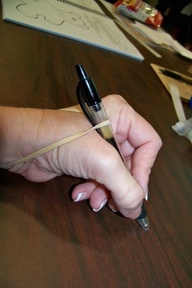
- Use different pens and pencils that are a comfortable fit for your little one. Sometimes-fat markers on the white board work best for little fingers.
- Use paper with raised lines to help guide staying within the lines.
A young child with Dysgraphia will need to practice letter formation using multisensory writing strategies to improve motor memory. They will need to move, touch, feel and manipulate real objects as they learn the habits and skills essential for writing. Some examples are:
1. Have the child first write the letter in the air with two fingers. Then they can trace over a yellow highlighted letter. Finally, they can write the modeled and traced letter independently on a whiteboard or piece of paper.
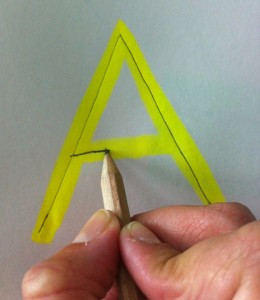
2. Use the wet-dry-try method. Children write the letter on a chalkboard with a wet sponge using the correct letter formation. Afterwards, they dry the letter with a dry sponge using the correct formation. Then, they rewrite the letter correctly again with a piece of chalk.
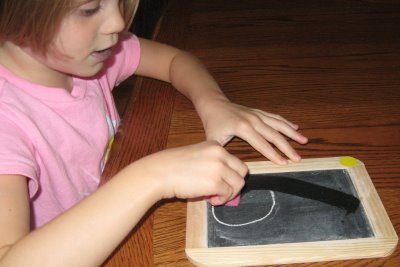
3. Build letters out of clay or play dough
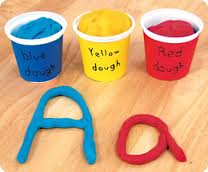
4. Use shaving cream to write the letters
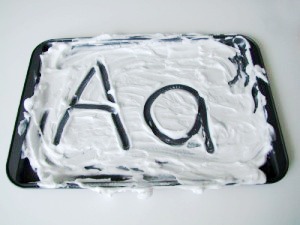
5. Trace letters on a piece of sandpaper or a bumpy surface
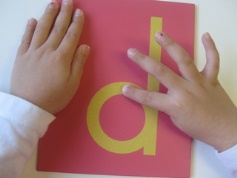
6. Speak out loud while writing the letters. For example, speaking through motor sequences, such as “b” is “first comes the bat, then comes the ball.”

In Elementary School:
- Introduce a keyboarding program on the computer or tablet as soon as possible. Typing can make it easier for a child with Dysgraphia to write by alleviating the frustration of forming the letters.
- Give the child extra time to complete writing activities.
- Have the child proofread the work later in the day. It is easier to see mistakes after taking a break.
- Help the child create a checklist of editing their own work. This can include spelling, neatness, grammar, syntax, written expression.
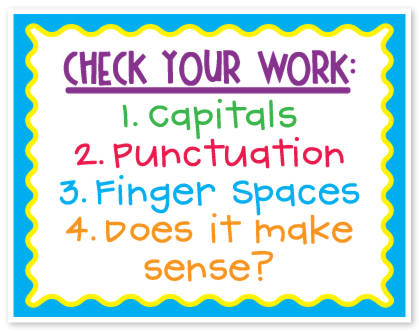
- Encourage the use of a spell checker
- Students can first verbally talk into a recorder to express their ideas and then follow up by writing them afterwards.
- Create a well-organized plan that breaks writing assignments into small tasks.
- Use games and movement activities to reinforce spelling and sight words. Some examples are:
- Bounce a Ball – bounce a ball as you spell words. 1 bounce per letter.
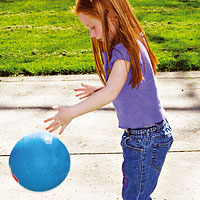
- Cheerleader Chant – Give me an S, give me a P, give me an E, give me an L, give me a L, give me another L – what’s that spell? SPELL!
- Jumping Jacks – Instead of writing the words, the student can spell them aloud while doing jumping jacks.

A student with Dysgraphia will benefit from being explicitly taught the steps of the writing process. Just as these students were taught to read in a step-by-step process, they will also need explicit and direct instruction in writing.
Students who struggle with Dysgraphia will need to explicitly be taught different types of writing such as expository and personal essays, short stories, poems, etc. This means that a teacher will need to provide these students with specific ideas and instructions. As part of these writing lessons, students will need to be given “visualization” strategies and mnemonics, which are a fun and easy strategy for remembering essential steps in the writing process.
Children struggling with Dysgraphia will need a structured, sequential, systematic, cumulative and multisensory writing program to help them build lasting memories. This might require more one-on-one sessions with a trained writing teacher, parent or tutor.
Learn more about the New PRIDE Reading Program
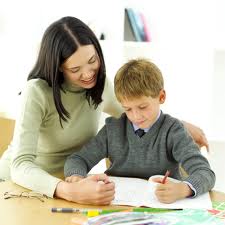
__________________________________________________________________________________________________________
Karina Richland, M.A. is the Founder of PRIDE Learning Centers, located in Los Angeles and Orange County. Ms. Richland is a certified reading and learning disability specialist. Ms. Richland speaks frequently to parents, teachers, and professionals on learning differences, and writes for several journals and publications. You can visit the PRIDE Learning Center website at: www.pridelearningcenter.com

by PRIDE Reading Program Admin | Apr 19, 2015 | A PRIDE Post, Reading Comprehension
Reading comprehension is not an easy activity. In fact, it can be really hard work! Did you know that without proper interventions, 74% of the children who are poor readers in third grade remain poor readers in the ninth grade? Reading comprehension impacts all subjects in school including literature, science, social studies and even math. For students to do well academically, they must be able to comprehend the material they are reading. Reading research shows that good readers:
- are active readers and have goals in mind as they are working through a text.
- make predictions about what is to come
- look over the structure of the text before they read to determine which sections are the most relevant to their reading goals.
- read selectively, determining which sections to read carefully , which to read quickly, which not to read, and so on.
- construct, revise, and question the meanings they make as they read.
- try to determine meaning of unfamiliar words and concepts in the text.
- read various types of texts differently. In narrative, a good reader pays close attention to the setting and characters but in expository text, a good reader frequently summarizes what they have read.
- Feel a sense of satisfaction and productivity after reading a text
Research according to the National Reading Panel 2000, has proven that explicit and direct instruction is the core of good reading comprehension. Children need to learn to use comprehension strategies before, during and after they read. Here are a few research-based strategies that help students become active readers:
Predictions
Students are encouraged to generate expectations about what characters might do, or how the plot might evolve, based on their own experiences in similar situations. Making a prediction activates the student’s prior knowledge and therefore provides a foundation for any new information they will learn while reading. This prior knowledge facilitates their understanding of new ideas encountered in text. Researchers in the field of reading comprehension (Anderson, Wilkinson, Mason, & Shirey, 1990) found that prediction activities promoted overall story understanding if the predictions were explicitly compared to text ideas during further reading. Some activities that support predicting include:
- read the title of the book and discuss what clues about the story does the title provide
- discuss the illustration on the cover and ask student what it makes them think of
- discuss if this is a real or make-believe story
Think-aloud
Think-aloud involves making one’s thoughts audible and saying what you are thinking while you are reading. This strategy has been shown to improve students’ comprehension when both students themselves engage in the think-aloud and when teachers also use think aloud while reading to students. A study by Bereiter and Bird (1985) showed that students who were asked to think aloud while reading had better comprehension than students who were not taught to think aloud, according to a question-and-answer comprehension test. Another study by Silven and Vauras (1992) demonstrated that students who were prompted to think aloud as part of their comprehension training were better at summarizing information in a text than students whose training did not include think-aloud. An example of a think aloud goes something like this:
The teacher reads a section of a text and talks out loud to the children to show that he/she is engaged and reading actively.
- “This reminds me of a time when I…”
- “I wonder why…”
- “I know about this topic because I…”
Story Structure
Story structure involves how stories and plots are organized. Essentially every reader is taken down a path with characters, a setting, some sort of activity or conflict and a resolution. Understanding this structure of the story or plot is conducive to understanding and deriving meaning from literature. It enables the child to organize in his or her mind what exactly they are reading. Some activities that support story structure include:
- create and fill out a chart detailing the four parts of a story, including the characters, plot, conflict, and resolution.
- draw or write a comic strip recreating the story
- Use a graphic organizer or story map to chart out the structure of the story
Visualization
Visualization involves picturing in your mind what is happening in the text. This can help transform students from passive readers to active readers while simultaneously improving their reading comprehension. By vividly visualizing the events depicted in the text, creative readers allow themselves to become part of the story; they see the colors, hear the sounds, feel the textures, taste the flavors, and smell the odors the writer describes. The more the students practice this strategy, the more automatic it becomes during reading. Some activities that support students in visualizing include:
- sketch a picture while reading or listening to a descriptive story.
- look at wordless picture books and then write the words that would create the pictures in the books.
- dramatize a story
Summarization
To summarize a student needs to be able to pull out the main idea, focus on key details, use key words and phrases, and break down the larger ideas. Summarizing is an extremely difficult task for most students. Many children require instruction and practice in summarizing before they are able to produce good oral and written summaries of text. Some activities that support summarizing include:
- take articles from a newspaper and cut off the headlines and then have students write their own headlines of the story.
- with different colored highlighters have students underline key words, phrases, vocabulary and ideas that are relevant to understanding the text.
- use a graphic organizer with Who, What, When, Where, Why, and How.
Success in school and beyond depends in great measure upon the ability to read with strong comprehension. When students make connections to the text they are reading, their comprehension increases. Good readers constantly try to make meaning out of what they read by seeing how it fits with what they already know. When we help students make those connections before, during, and after they read, we are teaching them critical comprehension strategies that the best readers use almost instinctively.
Learn more about the New PRIDE Reading Program

Karina Richland, M.A. is the Founder and Director of PRIDE Learning Centers, located in Los Angeles and Orange County. Ms. Richland is a certified reading and learning disability specialist. Ms. Richland speaks frequently to parents, teachers, and professionals on learning differences, and writes for several journals and publications. You can visit the Pride Learning Center website at: www.pridelearningcenter.com


















